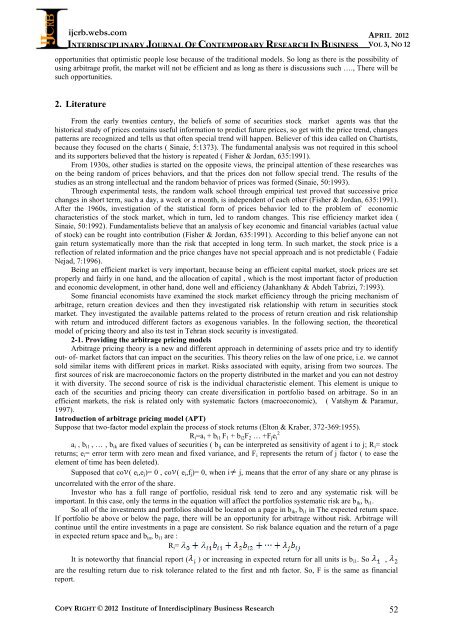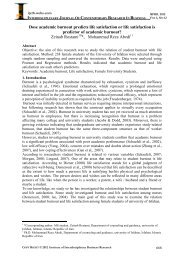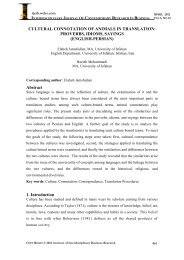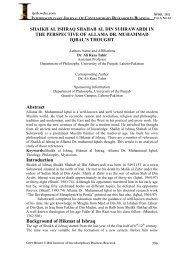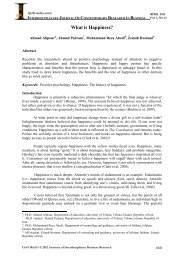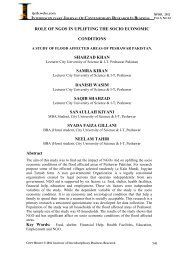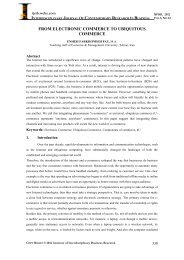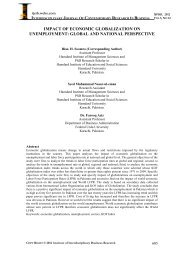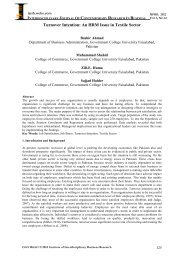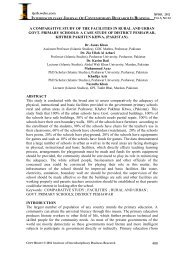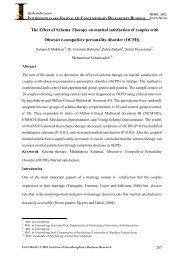evaluation of capital market efficiency using - journal-archieves17 ...
evaluation of capital market efficiency using - journal-archieves17 ...
evaluation of capital market efficiency using - journal-archieves17 ...
Create successful ePaper yourself
Turn your PDF publications into a flip-book with our unique Google optimized e-Paper software.
ijcrb.webs.com<br />
INTERDISCIPLINARY JOURNAL OF CONTEMPORARY RESEARCH IN BUSINESS<br />
COPY RIGHT © 2012 Institute <strong>of</strong> Interdisciplinary Business Research<br />
APRIL 2012<br />
VOL 3, NO 12<br />
opportunities that optimistic people lose because <strong>of</strong> the traditional models. So long as there is the possibility <strong>of</strong><br />
<strong>using</strong> arbitrage pr<strong>of</strong>it, the <strong>market</strong> will not be efficient and as long as there is discussions such …., There will be<br />
such opportunities.<br />
2. Literature<br />
From the early twenties century, the beliefs <strong>of</strong> some <strong>of</strong> securities stock <strong>market</strong> agents was that the<br />
historical study <strong>of</strong> prices contains useful information to predict future prices, so get with the price trend, changes<br />
patterns are recognized and tells us that <strong>of</strong>ten special trend will happen. Believer <strong>of</strong> this idea called on Chartists,<br />
because they focused on the charts ( Sinaie, 5:1373). The fundamental analysis was not required in this school<br />
and its supporters believed that the history is repeated ( Fisher & Jordan, 635:1991).<br />
From 1930s, other studies is started on the opposite views, the principal attention <strong>of</strong> these researches was<br />
on the being random <strong>of</strong> prices behaviors, and that the prices don not follow special trend. The results <strong>of</strong> the<br />
studies as an strong intellectual and the random behavior <strong>of</strong> prices was formed (Sinaie, 50:1993).<br />
Through experimental tests, the random walk school through empirical test proved that successive price<br />
changes in short term, such a day, a week or a month, is independent <strong>of</strong> each other (Fisher & Jordan, 635:1991).<br />
After the 1960s, investigation <strong>of</strong> the statistical form <strong>of</strong> prices behavior led to the problem <strong>of</strong> economic<br />
characteristics <strong>of</strong> the stock <strong>market</strong>, which in turn, led to random changes. This rise <strong>efficiency</strong> <strong>market</strong> idea (<br />
Sinaie, 50:1992). Fundamentalists believe that an analysis <strong>of</strong> key economic and financial variables (actual value<br />
<strong>of</strong> stock) can be rought into contribution (Fisher & Jordan, 635:1991). According to this belief anyone can not<br />
gain return systematically more than the risk that accepted in long term. In such <strong>market</strong>, the stock price is a<br />
reflection <strong>of</strong> related information and the price changes have not special approach and is not predictable ( Fadaie<br />
Nejad, 7:1996).<br />
Being an efficient <strong>market</strong> is very important, because being an efficient <strong>capital</strong> <strong>market</strong>, stock prices are set<br />
properly and fairly in one hand, and the allocation <strong>of</strong> <strong>capital</strong> , which is the most important factor <strong>of</strong> production<br />
and economic development, in other hand, done well and <strong>efficiency</strong> (Jahankhany & Abdeh Tabrizi, 7:1993).<br />
Some financial economists have examined the stock <strong>market</strong> <strong>efficiency</strong> through the pricing mechanism <strong>of</strong><br />
arbitrage, return creation devices and then they investigated risk relationship with return in securities stock<br />
<strong>market</strong>. They investigated the available patterns related to the process <strong>of</strong> return creation and risk relationship<br />
with return and introduced different factors as exogenous variables. In the following section, the theoretical<br />
model <strong>of</strong> pricing theory and also its test in Tehran stock security is investigated.<br />
2-1. Providing the arbitrage pricing models<br />
Arbitrage pricing theory is a new and different approach in determining <strong>of</strong> assets price and try to identify<br />
out- <strong>of</strong>- <strong>market</strong> factors that can impact on the securities. This theory relies on the law <strong>of</strong> one price, i.e. we cannot<br />
sold similar items with different prices in <strong>market</strong>. Risks associated with equity, arising from two sources. The<br />
first sources <strong>of</strong> risk are macroeconomic factors on the property distributed in the <strong>market</strong> and you can not destroy<br />
it with diversity. The second source <strong>of</strong> risk is the individual characteristic element. This element is unique to<br />
each <strong>of</strong> the securities and pricing theory can create diversification in portfolio based on arbitrage. So in an<br />
efficient <strong>market</strong>s, the risk is related only with systematic factors (macroeconomic), ( Vatshym & Paramur,<br />
1997).<br />
Introduction <strong>of</strong> arbitrage pricing model (APT)<br />
Suppose that two-factor model explain the process <strong>of</strong> stock returns (Elton & Kraber, 372-369:1955).<br />
Ri=ai + bi1 F1 + bi2F2 … +Fjei 2<br />
ai , bi1 , … , bik are fixed values <strong>of</strong> securities ( bij can be interpreted as sensitivity <strong>of</strong> agent i to j; Ri= stock<br />
returns; ei= error term with zero mean and fixed variance, and Fi represents the return <strong>of</strong> j factor ( to ease the<br />
element <strong>of</strong> time has been deleted).<br />
Supposed that co ( ei,ej)= 0 , co ( ei,fj)= 0, when i j, means that the error <strong>of</strong> any share or any phrase is<br />
uncorrelated with the error <strong>of</strong> the share.<br />
Investor who has a full range <strong>of</strong> portfolio, residual risk tend to zero and any systematic risk will be<br />
important. In this case, only the terms in the equation will affect the portfolios systematic risk are bik, bi1.<br />
So all <strong>of</strong> the investments and portfolios should be located on a page in bik, bi1 in The expected return space.<br />
If portfolio be above or below the page, there will be an opportunity for arbitrage without risk. Arbitrage will<br />
continue until the entire investments in a page are consistent. So risk balance equation and the return <strong>of</strong> a page<br />
in expected return space and bin, bi1 are :<br />
Ri=<br />
It is noteworthy that financial report ( ) or increasing in expected return for all units is bi1. So ,<br />
are the resulting return due to risk tolerance related to the first and nth factor. So, F is the same as financial<br />
report.<br />
52


